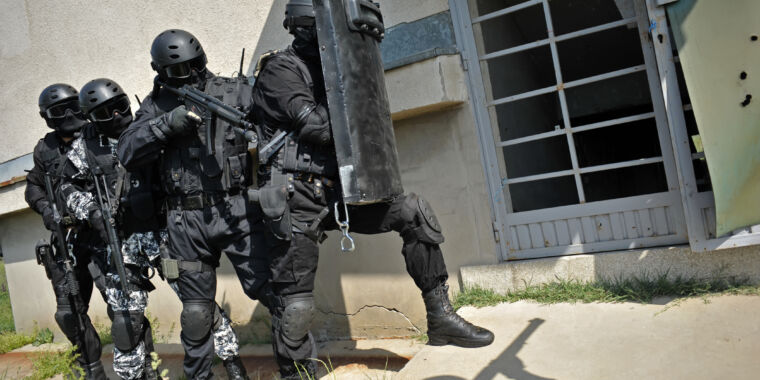
Twitch has faced scrutiny for how it helps streamers targeted by extreme hate campaigns. Last year, the livestreaming service started suing users conducting “hate raids” that rely on bots to spew a continual barrage of hate speech. These raids, Twitch’s lawsuit says, have been “targeting black and LGBTQIA+ streamers with racist, homophobic, sexist, and other harassing content.” Now, vulnerable users are hoping that Twitch will use its heft to stop some of the deadliest attacks affecting marginalized users on the platform: swatting that has reportedly been increasing since 2015 and that now happens multiple times a week.
These swatting attacks are conducted by anonymous persons making prank calls to police, falsely reporting emergency circumstances (like an armed potential mass shooter or a hostage situation that doesn’t exist) in order to get SWAT teams to descend, guns out, on a Twitch streamer’s location. The Washington Post reported this week that these swattings appear to be intensifying and can be traumatizing for targeted Twitch streamers. One trans Twitch streamer told the Post that police in London aimed an assault rifle at her face.
Official attempts to prevent swatting
Back in 2017, a person who was an unintended target died after a swatting sent officers to the wrong address. The Twitch user who set up that swatting, Casey Viner, was sentenced to 15 months in prison, while the man whom Viner hired to place the prank call, Tyler Barriss, was sentenced to 20 years.
Since then, local and state governments have taken some steps to prevent swattings. Seattle created a police anti-swatting service to help Twitch users warn police of potential false reports. Those efforts helped lead Washington state to enact an anti-swatting law in 2020, and other states have followed that example. Kentucky passed a law earlier this year making it a Class D felony to file false reports “involving danger to life or property” if they incite police to react. That means prank callers can be heavily penalized for initiating a police response or leading officers to circulate false allegations that are likely to cause public alarm.
“Imagine having your local police department’s tactical response team surround your home in preparation of breaking down the door in what they believe is a rescue or hostage situation, only to learn that this was someone’s idea of a joke?” Phillip Pratt (R-Ky.), who sponsored the Kentucky anti-swatting bill, told me. “That’s exactly what happened in my community in March of 2021 and in other cities across the nation over the past few years. Not only is this a dangerous misuse of our first responders, but it has also led to the death of innocent people.”
Maximum penalties for prank callers under anti-swatting laws are not as extreme as Barriss’ sentence. Under the Kentucky law, victims are eligible to receive damages, including for emotional distress, and anyone sentenced risks up to five years in prison. US Senator Charles Schumer (D-N.Y.) previously sought to pass a federal law to increase that maximum sentence to eight years, but it stalled. Another attempt at passing an anti-swatting law was introduced in Congress in 2019, but so far, it has gone nowhere.
Without federal guidance, costs could prevent states from pursuing these sorts of cases. Tracking down offenders making false reports can be excessively expensive. Law enforcement who arrested Barriss estimated that it cost $100,000 to identify “just one hoax caller.” It’s difficult because, the Post notes, “harassers can use software to spoof phone numbers and IP addresses,” and this can effectively mask their identities.
However, states may realize that more resources need to be dedicated, especially since the practice appears to be targeting more users more often. The Post reported four attacks this week alone—which is a lot, considering that the Kentucky law was enacted after an estimated 10 attacks occurred within a year. Schumer’s bill was based on 21 attacks in a single New York county back in 2014. While swattings are not exclusively a Twitch problem—users on Twitter and other online platforms are vulnerable, too—Twitch is among the most visible, mainly because some SWAT raids are livestreamed to wide audiences.








